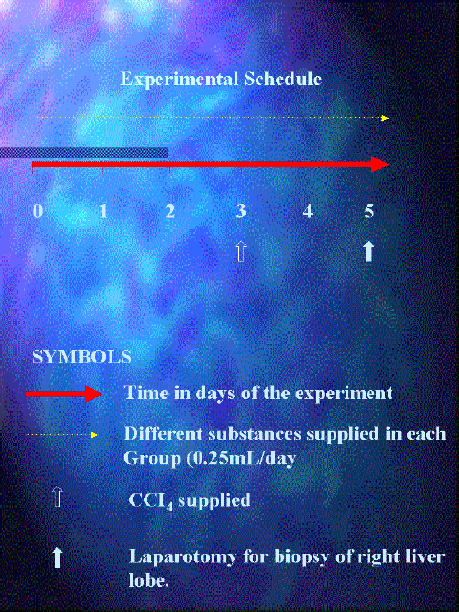Poster
Contents
| INABIS '98 Home Page | Your Poster Session | Related Symposia & Posters | Plenary Sessions | Exhibitors' Foyer | Personal Itinerary | New Search |
MATERIALS and METHODS
Cuban IFN
a 2B recombinant, prepared by William Schwabe Homeopathic Pharmacopoeia, in 10-4 U/ml (6CH), 10-22 U/ml (15CH) and 10-52 U/ml (30CH) in alcoholic solution 30% v/v.120 Wistar male adult rats between 200 and 250 g weight. Specific laboratory food ad libitum. They were kept in special environmental, illumination and epidemiological conditions.
Solutions were provided by mouth with metal hard tube within a plastic syringe of 1 ml capacity.
Hepatotoxic agent : carbon tetrachloride analytic quality, solved in olive oil a:a in 3 ml/kg weight doses.
METHODS
Experimental analytical trial prospective and transversal about possible hepatoprotector effect of homeopathic IFN in experimental hepatitis produced by CCI4 .
In table 1 may be seen the 5 rat groups for the study.
TABLE 1
SUBSTANCES USED AND NUMBER OF RATS IN EACH STUDY GROUP
GROUP I |
GROUP II |
GROUP III |
GROUP IV |
GROUP V |
water |
Hidroalcoholic Solution 30 % 30 CH |
IFN 6 CH |
IFN 15 CH |
IFN 30 CH |
24 rats |
24 rats |
24 rats |
24 rats |
24 rats |
Development of the experiment is shown in figure 1.
Fig. 1

On fifth day the rats were sacrificed, laparotomy was performed in order to obtain 1 sq cm of tissue fragments from hepatic right lobe.
Tissue was kept in formaldehyde 10%. Pathologist was blind to the groups.
Histological results interpretation was done by means of the following classification:
Micro and macrovacuolar esteatosis
Degree I mild up to 25 % of the total cells in the section
Degree II moderate between 26 and 60% of total cells in the section
Degree III severe more than 70%
Necrosis
Degree I mild isolated cells
Degree II moderate necrotic cells in center lobules with hemorrhage, structure of
Hepatic lobule is conserved.
Degree III severe hemorrage and breaking of structures. Evident necrosis.
Percentage of damaged cells was obtained in the basis of quasi quantitative bases of determinations for damaged cells overall observed.
Statistical Analysis
Statistical analysis was made with ANOVA test for analyzing the differences between means of percentages of damaged cells and turning the fraction into square root.
Correspondence factorial analysis was applied with the studied endpoints in order to determine in which group there were differences.
| Discussion Board | Next Page | Your Poster Session |